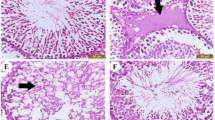The regenerative properties of p-tyrosol were investigated in a model of testicular insufficiency caused by a toxic effect on spermatogonial stem cells (single administration of paclitaxel in the maximum tolerable dose). Against the background of p-tyrosol administration, we observed an increase in the number of normal spermatogonia and Sertoli cells, stimulation of spermatogenesis, and renewal of the spermatogenic tissue. The treatment with p-tyrosol also led to a decrease in DNA damage in cells of the testicular tissue. These changes were accompanied by a decrease in the level of free radicals, an increase in antioxidant protection, and normalization of the redox potential.
Similar content being viewed by others
References
Borovskaya TG, Kamalova SI, Krivova NA, Zaeva OB, Poluektova ME, Vychuzhanina AV, Grigor’eva VA, Plotnikov MB, Goldberg VE. Experimental Study of the Effectiveness of Phenolic Antioxidants in Male Infertility Caused by Pathospermia. Bull. Exp. Biol. Med. 2018;166(1):7-10. doi: https://doi.org/10.1007/s10517-018-4276-6
Dygai AM, Chaikovskii AV, Zhdanov VV, Zyuz’kov GN, Stavrova LA, Udut VV, Miroshnichenko LA, Simanina EV, Borovskaya TG, Poluektova ME. Responses of Spermatogenous Tissue and Mechanisms of Their Development Upon Cytostatic Exposure. Bull. Exp. Biol. Med. 2015;159(6):743-746. doi: https://doi.org/10.1007/s10517-015-3064-9
Durnev AD, Smol’nikova NM, Skosyreva AM, Nemova EP, Solomina AS, Shreder OV, Gus’kova TA, Verstakova OL, Syubaev RD. Methodic Recommendations for Evaluation of Reproductive Toxicity of Pharmacological Substances. Manual for Preclinical Studies of New Pharmacological Substances. Part I, Mironov AN, ed. Moscow, 2012. P. 80-93. Russian.
Zhanataev AK, Nikitina VA, Voronina ES, Durnev AD. Methodological aspects of the assessment DNA damage by the DNA comet method. Priklad. Toksikol. 2011;2(4):27-37. Russian.
Sukhorukov VS, Shamshad DS. Determination of the degree of maturity of the rat spermatogenic layer during its regeneration and in the process of maturation of the intact testis. Arkh. Anat. Gistol. Embriol. 1989;97(9):89. Russian.
Angeloni C, Malaguti M, Barbalace MC, Hrelia S. Bioactivity of olive oil phenols in neuroprotection. Int. J. Mol. Sci. 2017;18(11):2230. doi: https://doi.org/10.3390/ijms18112230
Casado-Díaz A, Dorado G, Quesada-Gómez JM. Influence of olive oil and its components on mesenchymal stem cell biology. World J. Stem Cells. 2019;11(12):1045-1064. doi: https://doi.org/10.4252/wjsc.v11.i12.1045.
Forbes CM, Flannigan R, Schlegel PN. Spermatogonial stem cell transplantation and male infertility: Current status and future directions. Arab. J. Urol. 2017;16(1):171-180. doi: https://doi.org/10.1016/j.aju.2017.11.015
Kalaiselvan I, Dicson SM, Kasi PD. Olive oil and its phenolic constituent tyrosol attenuates dioxin-induced toxicity in peripheral blood mononuclear cells via an antioxidant-dependent mechanism. Nat. Prod. Res. 2015;29(22):2129-2132. doi: https://doi.org/10.1080/14786419.2014.989393
Karković Marković A, Torić J, Barbarić M, Jakobušić Brala C. Hydroxytyrosol, tyrosol and derivatives and their potential effects on human health. Molecules. 2019;24(10):2001. doi: https://doi.org/10.3390/molecules24102001
Mori Y, Ogonuki N, Hasegawa A, Kanatsu-Shinohara M, Ogura A, Wang Y, McCarrey JR, Shinohara T. OGG1 protects mouse spermatogonial stem cells from reactive oxygen species in culture. Biol. Reprod. 2021;104(3):706-716. doi: https://doi.org/10.1093/biolre/ioaa216
Muller CH, Lee TK, Montaño MA. Improved chemiluminescence assay for measuring antioxidant capacity of seminal plasma. Methods Mol. Biol. 2013;927:363-376. doi: https://doi.org/10.1007/978-1-62703-038-0_31
Plotnikov MB, Plotnikova TM. Tyrosol as a neuroprotector: strong effects of a “weak” antioxidant. Curr. Neuropharmacol. 2021;19(4):434-448. doi: https://doi.org/10.2174/1570159X18666200507082311
Sênos Demarco R, Jones DL. Redox signaling as a modulator of germline stem cell behavior: implications for regenerative medicine. Free Radic. Biol. Med. 2021;166:67-72. doi: https://doi.org/10.1016/j.freeradbiomed.2021.02.001
Zhang X, Xia Q, Wei R, Song H, Mi J, Lin Z, Yang Y, Sun Z, Zou K. Melatonin protects spermatogonia from the stress of chemotherapy and oxidation via eliminating reactive oxidative species. Free Radic. Biol. Med. 2019;137:74-86. doi: https://doi.org/10.1016/j.freeradbiomed.2019.04.009
Author information
Authors and Affiliations
Corresponding author
Additional information
Translated from Kletochnye Tekhnologii v Biologii i Meditsine, No. 4, pp. 228-232, December, 2021
Rights and permissions
About this article
Cite this article
Borovskaya, T.G., Grigor’eva, V.A., Shchemerova, Y.A. et al. Estimation of the Regenerative Potential of para-Tyrosol in the Model of Testicular Insufficiency Caused by Damage to Spermatogonial Stem Cells. Bull Exp Biol Med 172, 632–636 (2022). https://doi.org/10.1007/s10517-022-05452-z
Received:
Published:
Issue Date:
DOI: https://doi.org/10.1007/s10517-022-05452-z



